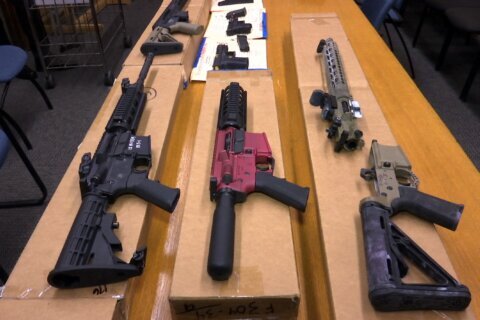SACRAMENTO, Calif. (AP) — The California Supreme Court on Thursday upheld the conviction and death penalty for one of two men implicated in at least 11 notorious horrific torture-slayings in the mid-1980s in which the duo kept their victims hidden in a secret bunker in the Northern California woods.
Thirty-seven years later, authorities are still trying to identify the remains of some of their victims.
Charles Ng, now 61, was convicted in 1999 of killing six men, three women and two baby boys in 1984 and 1985. He was initially accused of 13 slayings — 12 in Calaveras County and one in San Francisco.
He and his criminal partner, Leonard Lake, committed a series of kidnappings in which they engaged in bondage and sadism ending in murder. They were initially suspected of killing up to 25 people.
“This is one of those stories that’s been passed down through time in this community,” said Calaveras County Lt. Greg Stark, whose father worked for the department at the time of the slayings. “There’s been wild estimates and there’s been conservative estimates, and honestly I don’t think anybody will ever know, due to how they were disposing of the bodies.”
Ng and Lake held their victims in a remote 2 1/2-acre Sierra Nevada fenced compound about 150 miles (241 kilometers) east of San Francisco. It included a bunker with three rooms, two of them behind a hidden doorway. One hidden, locked room was furnished like a cell with a bed covered with a foam pad, a plastic bucket and a roll of toilet paper.
Lake killed himself with a cyanide capsule after police arrested him for shoplifting in San Francisco in 1985 and were questioning him before any bodies were found.
The justices said in a detailed 181-page analysis of the case that Ng received a fair trial, including a change of venue from Calaveras County to Orange County because of pre-trial publicity.
It was one of California’s longest and most expensive trials at the time, costing millions of dollars, partly because the court said Ng repeatedly attempted to delay and disrupt his own trial. That included extended debates over whether he could represent himself and who would be his attorneys.
The justices unanimously also concluded that Ng was properly extradited after he fled to Canada, where he was arrested in Calgary, Alberta, in 1985 for shoplifting and wounding a store guard. He fought extradition for six years before the Supreme Court of Canada ordered him returned.
The men incriminated themselves with videotapes of them tormenting bound, terrified women they used as sex slaves before their murders.
Jurors were shown a tape of one woman pleading in vain for the men to spare her husband and baby as Ng cut off her shirt and bra with a knife in front of the camera.
Investigators also discovered piles of charred bones, blood-stained tools, shallow graves and a 250-page diary kept by Lake.
Four law enforcement agencies spent five weeks scouring the property, according to the court’s detailed description.
They found thousands of buried teeth and bone fragments throughout the property, with at least four of the dental specimens belonging to a child under age 3. “Many hundreds” of the bone fragments had been burned.
Two forensic anthropologists eventually concluded that the remains belonged to at least four adults, one child, and one infant. Two men were found in a shallow grave not far from the property. They had been bound, gagged and fatally shot.
Officials in Calaveras County last year exhumed additional bones and other human remains from a crypt in a cemetery where they had been kept since Ng’s conviction, in hopes that modern DNA tracing could reveal their identities.
A sheriff’s chaplain read a brief invocation, and soon California Department of Justice criminalists and two forensic anthropologists began sorting and analyzing the remains.
They are initially hopeful that enough viable DNA is left for a comparison, said Stark, but the Department of Justice hasn’t yet been able to run the comparisons in part because of more urgent active cases.
Investigators plan to compare the DNA to that from cooperating next of kin of the known victims, and run it through DNA databases in hopes of a comparison.
“Regardless if there are 11 (slayings) or more than 11, we’re hoping to categorize the remains and if possible return them to the families to give them their due respect and internment,” Stark said. “If we find additional identifications, we’ll definitely look into them and their connection to the case.”
Ng joined the Marine Corps after he came to the United States from Hong Kong. He earlier was imprisoned at Leavenworth, Kansas, for weapons theft while serving in the Marine Corps.
He and his defense attorneys argued that he was under the influence of Lake, an older man and survivalist who they said engineered the serial slayings. Ng denied participating in many of the crimes.
His attorneys argued at the time that Ng was shaped as a child, when he was beaten by his father.
Gov. Gavin Newsom has imposed a moratorium on the death penalty so long as he is governor, and Ng still has the possibility of other federal appeals.
Copyright © 2024 The Associated Press. All rights reserved. This material may not be published, broadcast, written or redistributed.







